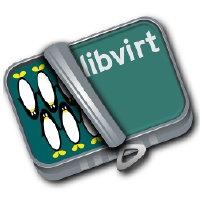
Virtualization
Run virtual machines at near-native speeds and manage them at ease

Run virtual machines at near-native speeds and manage them at ease
This documentation extends from the Offloading domain TTY output to console with custom kernel/initramfs images documentation, so it is highly recommended to read that document first.
In a headless virtual machine hosts accessible by SSH, the activities on a virtual machines can be discovered by offloading the console prompts on the current TTY. This is a great alternative to setting up SSH inside the virtual machine or connecting to the virtual machine via VNC or SPICE.
$ qemu-system-x86_64 \
-boot menu=on \
-m 2048 \
-cpu max \
-smp 4 \
-net nic \
-net user,hostfwd=tcp::6969-:8080 \
-drive file=datadrct/fedobios.raw,format=raw \
-accel kvm
$ uname -a

$ ls -la /boot

$ sudo cp /boot/<vmlinux-x.yy.zz-aaa-fcRR.x86_64> .
$ sudo cp /boot/<initramfs-x.yy.zz-aaa-fcRR.x86_64.img> .
$ ls -lh .

$ sudo chown $(whoami):$(whoami) <vmlinux-x.yy.zz-aaa-fcRR.x86_64>
$ sudo chown $(whoami):$(whoami) <initramfs-x.yy.zz-aaa-fcRR.x86_64.img>
$ ls -lh .

$ python3 -m http.server 8080

linxkrnl and initrmfs respectively.
$ wget http://localhost:6969/vmlinuz-x.yy.zz-aaa.fcRR.x86_64 -O linxkrnl/vmlinuz-x.yy.zz-aaa.fcRR.x86_64
$ wget http://localhost:6969/initramfs-x.yy.zz-aaa.fcRR.x86_64.img -O initrmfs/initramfs-x.yy.zz-aaa.fcRR.x86_64.img
$ ls -lh linxkrnl/
total 52M
-rwxr-xr-x. 1 t0xic0der t0xic0der 11M Aug 2 15:35 vmlinuz-0-rescue-8ee701c92f0f486cbb7afe96e5b7ea67
-rw-rw-r--. 1 t0xic0der t0xic0der 11M Aug 3 10:38 vmlinuz-5.11.12-300.fc34.x86_64
-rwxr-xr-x. 1 t0xic0der t0xic0der 11M Aug 2 15:35 vmlinuz-5.13.4-200.fc34.x86_64
-rwxr-xr-x. 1 t0xic0der t0xic0der 11M Aug 2 15:35 vmlinuz-5.13.5-200.fc34.x86_64
-rwxr-xr-x. 1 t0xic0der t0xic0der 11M Aug 2 15:35 vmlinuz-5.13.6-200.fc34.x86_64
$ ls -lh initrmfs/
total 204M
-rw-------. 1 t0xic0der t0xic0der 81M Aug 2 15:36 initramfs-0-rescue-8ee701c92f0f486cbb7afe96e5b7ea67.img
-rw-rw-r--. 1 t0xic0der t0xic0der 29M Aug 3 10:38 initramfs-5.11.12-300.fc34.x86_64.img
-rw-------. 1 t0xic0der t0xic0der 32M Aug 2 15:36 initramfs-5.13.4-200.fc34.x86_64.img
-rw-------. 1 t0xic0der t0xic0der 32M Aug 2 15:36 initramfs-5.13.5-200.fc34.x86_64.img
-rw-------. 1 t0xic0der t0xic0der 32M Aug 2 15:36 initramfs-5.13.6-200.fc34.x86_64.img
$ cat /proc/cmdline
BOOT_IMAGE=(hd0,msdos1)/vmlinuz-5.11.12-300.fc34.x86_64 root=UUID=0fa356e9-9509-4e18-8283-8983254c79d1 ro rhgb quiet
Take a note of the UUID for the root partition and the same can be confirmed by executing the following command in a terminal session inside the virtualized domain.
$ cat /etc/fstab
#
# /etc/fstab
# Created by anaconda on Mon Aug 2 09:36:54 2021
#
# Accessible filesystems, by reference, are maintained under '/dev/disk/'.
# See man pages fstab(5), findfs(8), mount(8) and/or blkid(8) for more info.
#
# After editing this file, run 'systemctl daemon-reload' to update systemd
# units generated from this file.
#
UUID=0fa356e9-9509-4e18-8283-8983254c79d1 / ext4 defaults 1 1
UUID=2d2863bb-527b-4477-bae5-5955bdb44d7b /boot ext4 defaults 1 2
$ qemu-system-x86_64 \
-boot menu=on \
-m 2048 \
-cpu max \
-smp 4 \
-drive file=datadrct/fedobios.raw,format=raw \
-accel kvm \
-nographic \
-kernel linxkrnl/<vmlinuz-x.yy.zz-aaa.fcRR.x86_64> \
-initrd initrmfs/<initramfs-x.yy.zz-aaa.fcRR.x86_64.img> \
-append "root=UUID=<xxxxxxxx-xxxx-xxxx-xxxx-xxxxxxxxxxxx> rw console=ttyS0"
systemd prompts would show up on the console and the virtualized domain would boot up. The following is an example output for the above command.
...
[ OK ] Started Network Manager Script Dispatcher Service.
[ OK ] Finished Network Manager Wait Online.
[ OK ] Reached target Network is Online.
[ OK ] Reached target Remote File Systems (Pre).
[ OK ] Reached target Remote File Systems.
Starting Virtualization daemon...
Starting Notify NFS peers of a restart...
Starting Permit User Sessions...
[ OK ] Started Notify NFS peers of a restart.
[ OK ] Finished Permit User Sessions.
Starting GNOME Display Manager...
Starting Hold until boot process finishes up...
[ OK ] Started GNOME Display Manager.
Fedora 34 (Workstation Edition)
Kernel 5.13.6-200.fc34.x86_64 on an x86_64 (ttyS0)
fedora login: t0xic0der
Password:
Last login: Tue Aug 3 10:31:46 on tty2
[t0xic0der@fedora ~]$
$ ip a
1: lo: <LOOPBACK,UP,LOWER_UP> mtu 65536 qdisc noqueue state UNKNOWN group default qlen 1000
link/loopback 00:00:00:00:00:00 brd 00:00:00:00:00:00
inet 127.0.0.1/8 scope host lo
valid_lft forever preferred_lft forever
inet6 ::1/128 scope host
valid_lft forever preferred_lft forever
2: ens3: <BROADCAST,MULTICAST,UP,LOWER_UP> mtu 1500 qdisc fq_codel state UP group default qlen 1000
link/ether 52:54:00:12:34:56 brd ff:ff:ff:ff:ff:ff
altname enp0s3
inet 10.0.2.15/24 brd 10.0.2.255 scope global dynamic noprefixroute ens3
valid_lft 86298sec preferred_lft 86298sec
inet6 fec0::26ff:70eb:26b2:5923/64 scope site dynamic noprefixroute
valid_lft 86302sec preferred_lft 14302sec
inet6 fe80::486a:c7b3:ca0a:43cf/64 scope link noprefixroute
valid_lft forever preferred_lft forever
As evidenced by the output of the above command executed inside the console of the virtualized domain, the kernel modules for network now work just fine and the hostname of the virtualized host has been retained as the kernel images, initramfs images and installed firmware versions correspond with each other.
Authors: Akashdeep Dhar, Jarek Prokop, Nick Dirschel